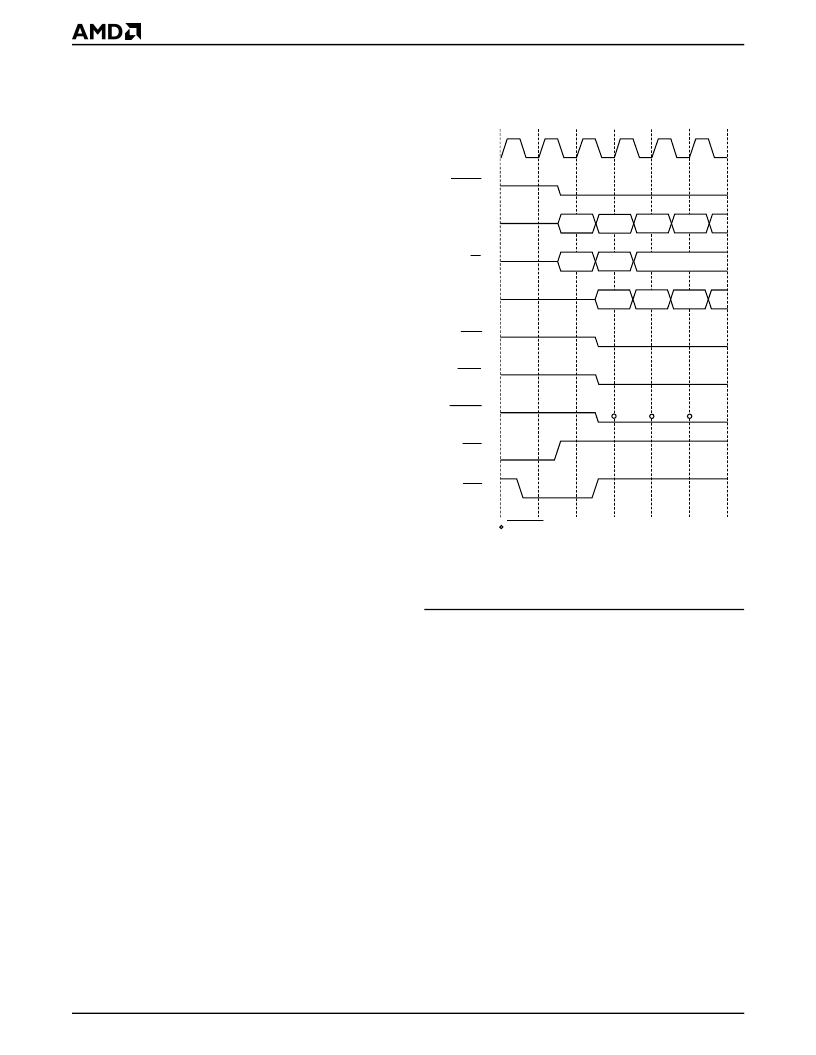- 您現(xiàn)在的位置:買賣IC網(wǎng) > PDF目錄366550 > AM79C971KCW (ADVANCED MICRO DEVICES INC) IC LOGIC 16211 24-BIT FET BUS SWITCH -40+85C TSSOP-56 35/TUBE PDF資料下載
參數(shù)資料
| 型號: | AM79C971KCW |
| 廠商: | ADVANCED MICRO DEVICES INC |
| 元件分類: | 微控制器/微處理器 |
| 英文描述: | IC LOGIC 16211 24-BIT FET BUS SWITCH -40+85C TSSOP-56 35/TUBE |
| 中文描述: | 4 CHANNEL(S), 100M bps, LOCAL AREA NETWORK CONTROLLER, PQFP16 |
| 封裝: | PLASTIC, QFP-160 |
| 文件頁數(shù): | 52/265頁 |
| 文件大小: | 3190K |
| 代理商: | AM79C971KCW |
第1頁第2頁第3頁第4頁第5頁第6頁第7頁第8頁第9頁第10頁第11頁第12頁第13頁第14頁第15頁第16頁第17頁第18頁第19頁第20頁第21頁第22頁第23頁第24頁第25頁第26頁第27頁第28頁第29頁第30頁第31頁第32頁第33頁第34頁第35頁第36頁第37頁第38頁第39頁第40頁第41頁第42頁第43頁第44頁第45頁第46頁第47頁第48頁第49頁第50頁第51頁當(dāng)前第52頁第53頁第54頁第55頁第56頁第57頁第58頁第59頁第60頁第61頁第62頁第63頁第64頁第65頁第66頁第67頁第68頁第69頁第70頁第71頁第72頁第73頁第74頁第75頁第76頁第77頁第78頁第79頁第80頁第81頁第82頁第83頁第84頁第85頁第86頁第87頁第88頁第89頁第90頁第91頁第92頁第93頁第94頁第95頁第96頁第97頁第98頁第99頁第100頁第101頁第102頁第103頁第104頁第105頁第106頁第107頁第108頁第109頁第110頁第111頁第112頁第113頁第114頁第115頁第116頁第117頁第118頁第119頁第120頁第121頁第122頁第123頁第124頁第125頁第126頁第127頁第128頁第129頁第130頁第131頁第132頁第133頁第134頁第135頁第136頁第137頁第138頁第139頁第140頁第141頁第142頁第143頁第144頁第145頁第146頁第147頁第148頁第149頁第150頁第151頁第152頁第153頁第154頁第155頁第156頁第157頁第158頁第159頁第160頁第161頁第162頁第163頁第164頁第165頁第166頁第167頁第168頁第169頁第170頁第171頁第172頁第173頁第174頁第175頁第176頁第177頁第178頁第179頁第180頁第181頁第182頁第183頁第184頁第185頁第186頁第187頁第188頁第189頁第190頁第191頁第192頁第193頁第194頁第195頁第196頁第197頁第198頁第199頁第200頁第201頁第202頁第203頁第204頁第205頁第206頁第207頁第208頁第209頁第210頁第211頁第212頁第213頁第214頁第215頁第216頁第217頁第218頁第219頁第220頁第221頁第222頁第223頁第224頁第225頁第226頁第227頁第228頁第229頁第230頁第231頁第232頁第233頁第234頁第235頁第236頁第237頁第238頁第239頁第240頁第241頁第242頁第243頁第244頁第245頁第246頁第247頁第248頁第249頁第250頁第251頁第252頁第253頁第254頁第255頁第256頁第257頁第258頁第259頁第260頁第261頁第262頁第263頁第264頁第265頁

52
Am79C971
Burst FIFO DMA Transfers
Bursting is only performed by the Am79C971 controller
if the BREADE and/or BWRITE bits of BCR18 are set.
These bits individually enable/disable the ability of the
Am79C971 controller to perform burst accesses during
master read operations and master write operations,
respectively.
A burst transaction will start with an address phase, fol-
lowed by one or more data phases. AD[1:0] will always
be 0 during the address phase indicating a linear burst
order.
During FIFO DMA read operations, all byte lanes will
always be active. The Am79C971 controller will inter-
nally discard unused bytes. During the first and the last
data phases of a FIFO DMA burst write operation, one
or more of the byte enable signals may be inactive. All
other data phases will always write a complete DWord.
Figure 29 shows the beginning of a FIFO DMA write
with the beginning of the buffer not aligned to a DWord
boundary. The Am79C971 controller starts off by writ-
ing only three bytes during the first data phase. This op-
eration aligns the address for all other data transfers to
a 32-bit boundary so that the Am79C971 controller can
continue bursting full DWords.
If a receive buffer does not end on a DWord boundary,
the Am79C971 controller will perform a non-DWord
write on the last transfer to the buffer. Figure 30 shows
the final three FIFO DMA transfers to a receive buffer.
Since there were only nine bytes of space left in the re-
ceive buffer, the Am79C971 controller bursts three data
phases. The first two data phases write a full DWord,
the last one only writes a single byte.
Note that the Am79C971 controller will always perform
a DWord transfer as long as it owns the buffer space,
even when there are less then four bytes to write. For
example, if there is only one byte left for the current re-
ceive frame, the Am79C971 controller will write a full
DWord, containing the last byte of the receive frame in
the least significant byte position (BSWP is cleared to
0, CSR3, bit 2). The content of the other three bytes is
undefined. The message byte count in the receive de-
scriptor always reflects the exact length of the received
frame.
If the end of a receive buffer is not aligned to a DWord
boundary, IWAIT (BCR18, bit 10) must stay at its de-
fault value of 0. This will result in one wait state added
to every data phase in a burst write transaction. When
the software ensures that all receive buffers end on a
DWord boundary, IWAIT can be set to 1. In this mode,
the Am79C971 controller will only insert a wait state in
the first data phase of the burst write transaction.
Figure 29.
FIFO Burst Write At Start Of Unaligned
Buffer
In a PCI bus application, the Am79C971 controller
should be set up to have the length of a bus mastership
period be controlled only by the PCI Latency Timer.
The Timer bit (CSR4, bit 13) should remain at its de-
fault value of 0. In this mode, the Am79C971 controller
will continue transferring FIFO data until the transmit
FIFO is filled to its high threshold (read transfers) or the
receive FIFO is emptied to its low threshold (write
transfers), or the Am79C971 controller is preempted,
and the PCI Latency Timer is expired. The host should
use the values in the PCI MIN_GNT and MAX_LAT reg-
isters to determine the value for the PCI Latency Timer.
In applications that do not use the PCI Latency Timer
or that do not support preemption, the following rules
apply to limit the time the Am79C971 controller takes
on the bus:
FRAME
CLK
AD
IRDY
TRDY
C/BE
DEVSEL
REQ
GNT
1
2
3
4
5
6
0000
0111
PAR
PAR
PAR
DEVSEL is sampled
0001
PAR
DATA
DATA
DATA
ADD
20550D-32
相關(guān)PDF資料 |
PDF描述 |
|---|---|
| AM79C972BKCW | PCnet⑩-FAST+ Enhanced 10/100 Mbps PCI Ethernet Controller with OnNow Support |
| AM79C972BKIW | PCnet⑩-FAST+ Enhanced 10/100 Mbps PCI Ethernet Controller with OnNow Support |
| AM79C972BVCW | PCnet⑩-FAST+ Enhanced 10/100 Mbps PCI Ethernet Controller with OnNow Support |
| AM79C972 | PCnet⑩-FAST+ Enhanced 10/100 Mbps PCI Ethernet Controller with OnNow Support |
| AM79C972BVIW | PCnet⑩-FAST+ Enhanced 10/100 Mbps PCI Ethernet Controller with OnNow Support |
相關(guān)代理商/技術(shù)參數(shù) |
參數(shù)描述 |
|---|---|
| AM79C971VCW | 制造商:AMD 制造商全稱:Advanced Micro Devices 功能描述:PCnet⑩-FAST Single-Chip Full-Duplex 10/100 Mbps Ethernet Controller for PCI Local Bus |
| AM79C972 | 制造商:AMD 制造商全稱:Advanced Micro Devices 功能描述:PCnet⑩-FAST+ Enhanced 10/100 Mbps PCI Ethernet Controller with OnNow Support |
| AM79C972BKC\\W | 制造商:Advanced Micro Devices 功能描述: |
| AM79C972BKC\W | 制造商:Advanced Micro Devices 功能描述: |
| AM79C972BKCW | 制造商:AMD 制造商全稱:Advanced Micro Devices 功能描述:PCnet⑩-FAST+ Enhanced 10/100 Mbps PCI Ethernet Controller with OnNow Support |
發(fā)布緊急采購,3分鐘左右您將得到回復(fù)。